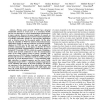Free Online Productivity Tools
i2Speak
i2Symbol
i2OCR
iTex2Img
iWeb2Print
iWeb2Shot
i2Type
iPdf2Split
iPdf2Merge
i2Bopomofo
i2Arabic
i2Style
i2Image
i2PDF
iLatex2Rtf
Sci2ools
ICCCN
2007
IEEE
2007
IEEE
Implementation of a Wireless Mesh Network Testbed for Traffic Control
Wireless mesh networks (WMN) have attracted considerable interest in recent years as a convenient, flexible and low-cost alternative to wired communication infrastructures in many contexts. However, the great majority of research on metropolitan-scale WMN has been centered around maximization of available bandwidth, suitable for non-real-time applications such as Internet access for the general public. On the other hand, the suitability of WMN for mission-critical infrastructure applications remains by and large unknown, as protocols typically employed in WMN are, for the most part, not designed for real-time communications. In this paper, we describe the Smart Transport and Roads Communications (STaRComm) project at National ICT Australia (NICTA), which sets a goal of designing a wireless mesh network architecture to solve the communication needs of the traffic control system in Sydney, Australia. This system, known as SCATS (Sydney Coordinated Adaptive Traffic System) and used in ove...
Communications | ICCCN 2007 | Sydney Coordinated Adaptive Traffic System | Traffic Lights | Wireless Mesh Network |
| Added | 16 Aug 2010 |
| Updated | 16 Aug 2010 |
| Type | Conference |
| Year | 2007 |
| Where | ICCCN |
| Authors | Kun-Chan Lan, Zhe Wang, Rodney Berriman, Tim Moors, Mahbub Hassan, Lavy Libman, Maximilian Ott, Björn Landfeldt, Zainab R. Zaidi, Aruna Seneviratne |
Comments (0)

